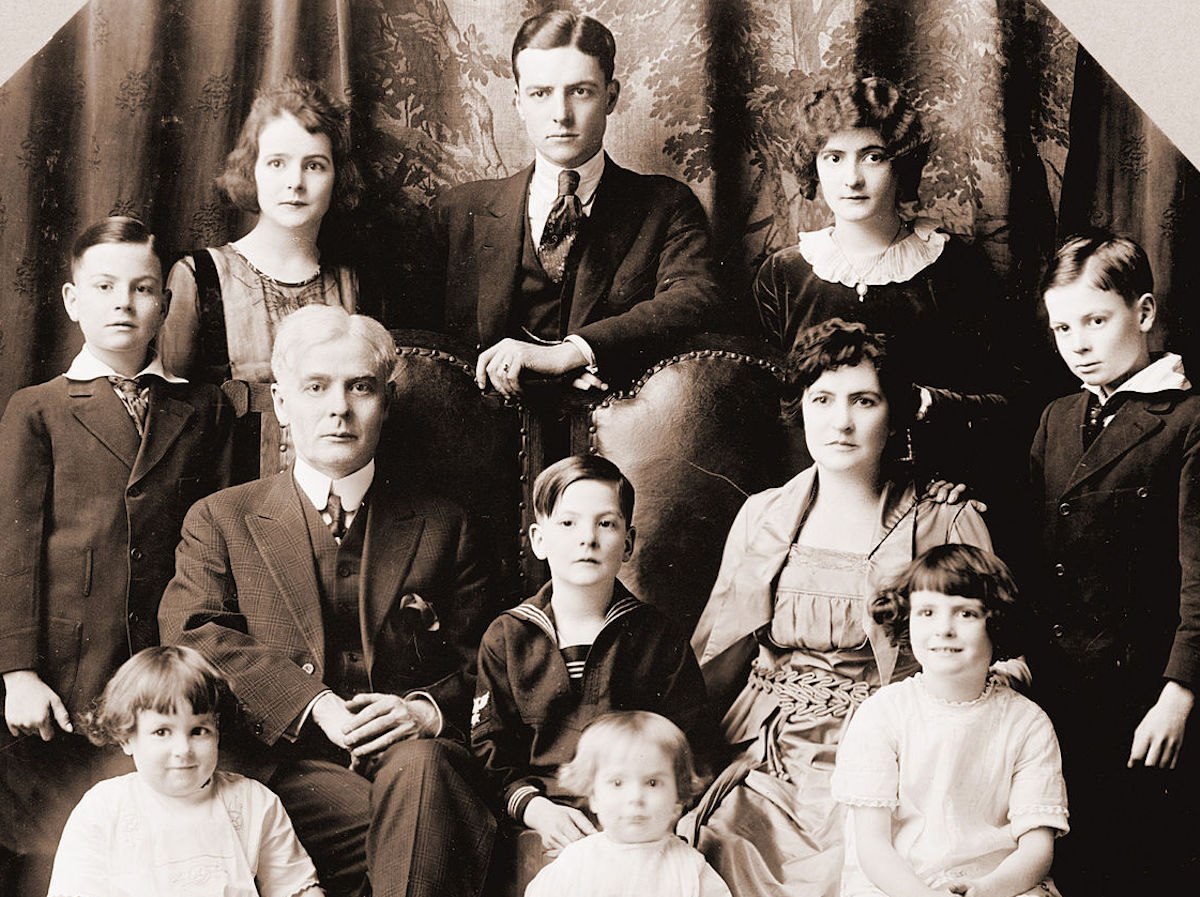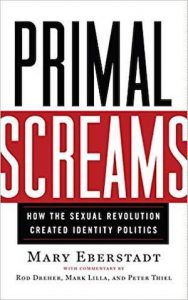recent
'The Great Scattering': How Identity Panic Took Root in the Void Once Occupied by Family Life
The panic over identity, in short, is being driven by the fact that the human animal has been selected for familial forms of socialization that for many people no longer exist.

Of all the issues that divide us, none seems as inimical to reasoned discussion as identity politics. Conservatives excoriate such politics as politically opportunistic theater, the acting out of coddled “snowflake” students. Liberals and progressives put forth an opposing grievance-first narrative, arguing that identity politics emanates from authentic wounds.
But what if both contenders have a piece of the truth? What if many identity-firsters today are claiming to be victims because they and their societies are victims—only not so much of the abstract “isms” they denounce, but of something else that till now has eluded description?
Let’s try a new theory: Our macro-politics have become a mania about identity because our micropolitics are no longer familial. This, above all, is what happened during the decades in which identity politics went from being a phrase in an obscure quasi-radical document to a way of being that has gone on to transform academia, law, media, culture and government.
Yes, racism, sexism and other forms of cruelty exist, and are always to be deplored and countered. At the same time, the timeline of identity politics suggest another source. Up until the middle of the twentieth century (and barring the frequent foreshortening of life by disease or nature) human expectations remained largely the same throughout the ages: that one would grow up to have children and a family; that parents and siblings and extended family would remain one’s primal community; and that, conversely, it was a tragedy not to be part of a family. The post-1960s order of sexual consumerism has upended every one of these expectations.
Who am I? is a universal human question. It becomes harder to answer if other basic questions are problematic or out of reach. Who is my brother? Who is my father? Where, if anywhere, are my cousins, grandparents, nieces, nephews and the rest of the organic connections through which humanity up until now channeled everyday existence? Every one of the assumptions that our forebears could take for granted is now negotiable.
The panic over identity, in short, is being driven by the fact that the human animal has been selected for familial forms of socialization that for many people no longer exist. Let’s test this theory, here dubbed the “Great Scattering,” via some evidence from social science, anthropology and pop culture.
* * *
Just how attenuated have family ties become? Consider a few examples.
When sociologists first began mapping the post-revolutionary empirical world beginning a little over half a century ago, they looked first, naturally enough, to the terrain that was easiest to see and measure: fatherlessness and its correlates. In his 1965 report, The Negro Family: The Case for National Action, future U.S. senator Daniel Patrick Moynihan argued that black poverty was tied fundamentally to the implosion of the black family, and worried over the rate of out-of-wedlock births—which was then around 25 percent, much higher than that of whites. That rate would continue to rise for both whites and blacks during the decades to come, and academics began connecting dots to show what was happening to children and adolescents in the new social order.
In 1997, one of the most eminent social scientists of the twentieth century, James Q. Wilson, summarized many of these findings succinctly in a speech that was later published as an essay. He identified the root of America’s fracturing in the dissolution of the family, and described what he called “the two nations” of America. The dividing line between these cleft territories was no longer one of income or social class, he argued. Instead, it had become all about the hearth.
“It is not money,” Wilson documented, “but the family that is the foundation of public life. As it has become weaker, every structure built upon that foundation has become weaker.” He pointed to the library that social science had been building for decades, filled with books and studies about the correlations between crumbling family structure and various adverse results. Kinship composition, as Wilson’s work among others demonstrated, had become more important to positive outcomes than race, income, or one’s station at birth.

Absent fathers have been only the most visible and measurable of the new family lacunae. In a landmark 2000 book called Between Two Worlds: The Inner Lives of Children of Divorce, Elizabeth Marquardt, working with sociologist Norval Glenn, reported on a study into the long-term effects of parental breakup into adulthood. She administered a lengthy questionnaire to 1,500 young adults, half of whose parents had split up by the time the children turned fourteen, and documented differences between children of divorce, and those who came from intact families.
At times, the two groups exhibited starkly opposed concepts of identity. For example, children of divorce were almost three times as likely to “strongly agree” with the statement, “I felt like a different person with each of my parents.” They were also twice as likely to “strongly agree” with the statement, “I always felt like an adult, even when I was a little kid”—a particularly poignant expression of confusion about the question “Who am I?” Almost two-thirds of the respondents of divorced homes also “agreed” with the following statement, which similarly expresses the division of oneself: “I felt like I had two families.”
This is evocative evidence, again, of the unsteady sense of self that many people, adult and child alike, now experience as the givens of life. It expresses the division of one into more than one—of selves torn, as in the book’s title, between worlds. And though these researchers limited their study to children of divorce only, their findings would also appear to apply to any home where two parents play a role in a child’s life from different locations.
Pop culture weighs in, too. In a 2004 Policy Review essay called Eminem Is Right, I documented how family rupture, family anarchy and family breakup had become the signature themes of Generation-X and Generation-Y pop. If yesterday’s rock was the music of abandon, today’s is that of abandonment. The odd truth about contemporary teenage music—the characteristic that most separates it from what has gone before—is its compulsive insistence on the damage wrought by broken homes, family dysfunction, checked-out parents, and (especially) absent fathers. Papa Roach, Everclear, Blink-182, Good Charlotte, Snoop Doggy Dogg—these and others have their own generational answer to what ails the modern teenager. That answer is: dysfunctional childhood. During the same years in which progressive-minded and politically correct adults have been excoriating Ozzie and Harriet as artifacts of 1950s-style oppression, millions of American teenagers have enshrined a new generation of music idols whose shared signature in song after song is to rage about what not having had a nuclear family had done to them.
In 2004, identity politics was not the omnipresent headline subject it is today. Even so, the effect of family decline on the sense of self already was appearing writ large across popular music. Tupac Shakur rapped about life with a single mother and no male parent, including in his 1993 Papa’z Song, about a boy who has to play catch by himself. Eddie Vedder of Pearl Jam and Kurt Cobain of Nirvana, both towering figures in 1990s rock, were children of divorce, and both referred back to that event repeatedly in their songs and interviews.
Above all, there is the fiery emotional connection that generations of teenagers have found in rap superstar Eminem. It exists not only on account of his extraordinary facility with language, but also, surely, for his signature themes: absent father, inattentive mother, protectiveness toward a sibling, and rage. Eminem is the Greek chorus of family dysfunction. And long before today’s brand of identity panics, a lot of young America already was stumbling over how to answer the question “Who am I?” Just listening to what they were driving up the charts proved the point.
* * *
Another demographic factor of note has been the shrinkage of most Western families, whether split or intact—one of whose consequences has been the diminishing number of people who grow up with siblings. It is now much more common for American mothers to have one or two children, rather than three or more, as was the case in the early 1960s. Singleton children have become the norm across much of Europe and parts of Asia, and the numbers are increasing in the United States. Many contemporary children and adolescents not only lack a parent—typically, a male parent. Many also have no siblings, or no sibling of either the same or the opposite sex.
Why might this matter? Because diverse findings show that being accompanied through early life by non-parental contemporaneous others (i.e., siblings) gives children and teenagers a leg up on socialization—in other words, knowing who they are in the social order.
A Canadian study published in 2018 suggests that siblings learn empathy from one another, independent of birth order. Another study has found that the likelihood of divorce later in life can be predicted by the number of siblings one has; the higher that number, the lower the likelihood of divorce. As with other analyses of the benefits of having brothers and sisters, the authors conjecture that the necessity of sharing resources prepares siblings for essential social skills later in life, such as bargaining and taking turns. One more study that made headlines recently showed that growing up with an opposite-sex sibling makes teenagers and young adults more confident and successful in the romance market, because they have had the opportunity to observe and interact at close range with a contemporaneous member of the opposite sex.
Such findings also are consonant with similar observations made from inquiries into animal behavior. One paper reviewing research into a variety of primates, including rhesus monkeys, baboons and macaques, concludes: “The bulk of the available evidence suggests that during childhood the nonhuman primates who grow up in the presence of siblings (or maternal half-sibs) will develop childhood social relationships with others in their social group earlier; and that these relationships will be of a more extensive nature than those formed by infants who grow up in the absence of siblings (or maternal half-sibs).”
* * *
Finally, another body of evidence that also speaks to our familial dislocation and isolation can be found in one of sociology’s hottest and fastest-growing stocks: loneliness studies.
Substantial numbers of men and women are suffering from what social scientists and medical professionals in their stricken societies call an “epidemic” of loneliness. Over half a century after the embrace of the sexual revolution, the paradox emerges that the materially better-off countries of the planet are also the most emotionally impoverished for many citizens, particularly though not only the elderly. Google any Western European or other advanced country followed by “loneliness,” and the same results appear: an outpouring of research on the new isolation.
This loneliness is a unique form of human poverty, abounding in societies awash in material wealth—places where, by the 1970s, divorce rates were rising, marriage rates were falling, and cradles were rapidly emptying.
Loneliness is no mere adolescent affectation. Social isolation on the scale found throughout the countries of the West is now exacting serious health costs that can be expected to rise as the Baby Boom generation enters its final years. Yet while senior citizens are the most visible objects of concern, they are not the only people so affected. One national survey conducted by health-service company Cigna, whose results were released in May, 2018, found that nearly half of all Americans report “sometimes or always” feeling alone, and that Generation Z—born between 1995 and 2010—is the loneliest generation of all.
Big Health takes an interest in social atomization for sound reasons. In their 2008 book, Loneliness: Human Nature and the Need for Social Connection, scientists John T. Cacioppo and William Patrick summarized evidence linking atomization to health risks, including a literature review in Science indicating that social isolation is a risk factor for illness and death whose effects are comparable to other, more familiar ones: high blood pressure, obesity, lack of exercise and smoking.
* * *
Wherever one stands in matters of the “culture wars” is immaterial. The plain fact is that the relative stability of yesterday’s familial identity could not help but answer the question at the heart of identity politics—Who am I?—in ways that now eludes many. The diminution and rupture of the family and the rise of identity politics cannot be understood apart from one another.
Anthropological evidence from every culture and era verifies that human beings, by their nature, live in families—just as coyotes and elephants and other mammals live in families, not just in random collections of individuals of the same species. Apart from the outlier that is the contemporary West, family has been an integral, unbidden demand of our kind, everywhere that human beings have been found. Its relational structure has provided the default ways of answering the question, Who am I? And now many people, deprived of a robust family life by post-1960s trends, can no longer figure out how to answer that question.
No wonder the flight to collective identities based on gender, ethnicity, and all the rest has become so impassioned. For more and more people, Narcissus can no longer find himself anywhere else.







